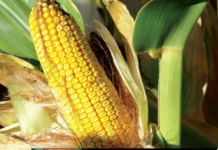By John Schlageck, Kansas Farm Bureau
This year Kansas has green fields, kissed by the sun. There are blue skies with white clouds high above. There are even valleys where rivers run. Heck, there’s even water standing in terrace channels.
It’s been at least five years since the pastures have been this green in the eastern half of the state and even in some of the drier areas of western Kansas the grass is showing signs of life.
If you’ve traveled anywhere in the state this summer, you can see what a little moisture can do, especially with the nurturing hands of our Kansas farmers.
Corn crops tower above the ground. Ten-feet tall is not unusual. Some farmers say some of their crops are 11 and 12-foot tall.
In Decatur County, far northwestern Kansas, farmers are hoping to harvest 90 to 100 bushel dry-land corn.
Grain sorghum fields sport huge heads nine, 10 and even 12 inches long. These heads are heavy filled with plump red and green berries.
Soybean leaves are the size of footballs. Pods weigh down the plants.
Calves graze in grass that nearly tickles their bellies. Even in the short-grass country of western Kansas, the buffalo grass is green and full of protein. Low spots and buffalo wallows are filled with life sustaining water. It’s a stark contrast to so many years when the grass has already turned brown, parched by the sun.
The Sunflower State has been truly blessed with moisture during the summer of 2014. Rainfall has been plentiful in many areas of our state.
Timely rains keep falling. In some areas of Kansas, farmers have stopped irrigating and are anxious for their fall crops to dry down. They’re ready to harvest.
The May family has farmed and ranched in Decatur County since 1887. Roger and Susan May are fourth-generation producers and they’re thankful for the moisture in 2014.
“It’s been a great year,” Roger says. “The cattle are looking good and in great shape. It’s been several years since our grass has been this green this late in the (growing) season.”
Plenty of showers, moisture from 35 to 60 hundreds of an inch, have been sure and steady throughout the summer, the Decatur County farmer/rancher says. They’ve also enjoyed a couple of more abundant rainfall events that totaled a couple inches. So far this year, nearly nine inches of rain has fallen on their land.
On this early September morning, temperatures hovered in the low 70s. Barn swallows bobbed and weaved in the sky searching for insects. Many of the insects are pesky black flies that pester the cattle and calves.
These insects don’t like to fly on such cool, early mornings. As the cattle kick them up from the ground, the swallows snatch them from the sky, eat them or carry them home to feed their hungry offspring.
Looking out the pickup window at his herd, Roger says he’d rank them at near the top on a scale of one to five. The plentiful moisture, good grass and plenty of milk for the calves has been a real asset this summer.
“They’re in top condition – they’re fleshy and their coats are sleek and shiny,” Roger says. “With these cows in such fine shape, they’ll raise a better, healthier calf this coming winter.”
The Mays manage a 350 head cow/calf operation as part of their farm and ranch operaton. Most years they feed the calves out to finish.
The cornerstone of his livestock operation has always involved making sure they have good feed, good nutrition and the proper health care. He likened his cattle to his family.
Each and every day the Decatur County stockman drives out to look at their herd. Once in the pasture, he meanders slowly through his stock, checking carefully for any sick cows or calves. Roger also checks to see if the cattle have water, mineral and salt.
Another important part of this daily routine is to count the stock and make sure they’re all inside the fence. The Decatur County stockman likes to keep his stock in his pastures.
“If you can keep livestock in, off your neighbor’s property and off the road, that’s a real accomplishment,” May says. “Every cattleman must keep track of his fences – make sure they’re in top repair.”
Like the poem by Frost says, “good fences make good neighbors.”
Yes sir, out here on the May place cattle have always been a major part of their operation. The better they take care of their livestock, the better the cattle will take care of them.
That’s the way it was with his dad and his grandfather before him. As a matter of fact, that’s the way Roger believes it will always be.
John Schlageck is a leading commentator on agriculture and rural Kansas. Born and raised on a diversified farm in northwestern Kansas, his writing reflects a lifetime of experience, knowledge and passion.
– See more at: http://www.kfb.org/news/insight/index.html#sthash.JhODSWBP.dpu




